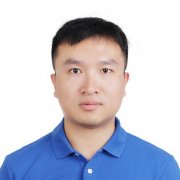戴奇
近期热点
资料介绍
个人简历
个人简介
2019.09至今:复旦大学工程与应用技术研究院 研究员
2015.06 – 2019.08:同济大学高等研究院、建筑与城市规划学院 研究员、博导
2012.01 – 2015.06:美国马赛诸塞州欧司朗公司(Osram Sylvania)先后任高级工程师、主任工程师
2011.05 – 2012.01:美国加州普瑞光电公司(Bridgelux) 工程师
2011.05:获美国伦斯勒理工学院(Rensselaer Polytechnic Institute)物理博士学位
2006.07:获复旦大学物理学士学位
代表性发明专利
[1] Q. Dai, M. Li, R. Harrison, E. Haidar, Planckian and non-planckian dimming of solid state light sources,获以下国家授权:
中国发明专利 CN104272870 / ZL2013800232182.2(授权日期2016年9月);
美国发明专利 US 9271362 (授权日期2016年2月);
欧洲发明专利 EP2845442(授权日期2018年4月);
加拿大发明专利 CA2868837(授权日期2016年11月)
[2] Q. Dai, B. Radl, R. Speer, R. Pereyra, Q. Huang, D. Harriott, Z. Wang, Formed three-dimensional lighting devices, 欧洲发明专利EP3198189(授权日期2018年9月)
[3] Q. Dai, B. Radl, R. Speer, Q. Huang, R. Pereyra, M. Tchoul, A. Scordino, L. Baldo, S. Bobbo, D. Pasqualini, G. van der Meer, S. Venk, Lighting devices including formed flexible light engines, 美国发明专利申请中(公开号US20180119902A1,公开日期2018年5月)
[4] M. Li, Q. Dai, K. Chen, Techniques for lumen maintenance and color shift compensation, 美国发明专利US 9335210(授权日期2016年5月)
[5] S. Venk, E. A. Picard, Jr., Q. Dai, R. Garner, “Conductor pad for flexible circuits and flexible circuit incorporating the same”, 美国发明专利US 9635759 (授权日期 2017年4月)
科研项目
[1]国家自然科学基金面上项目:基于节律、视觉二维参数的室内健康照明研究,项目批准号:51878464,2019/01-2022/12,主持
[2] 国家自然科学基金青年项目:基于人体节律效应的室内LED照明光谱优化研究,项目批准号:51608371,2017/01-2019/12,主持
[3] 横向项目“深海LED照明光源技术研究”,经费来源:中国船舶重工集团公司第七〇二研究所,2018.11-2019.5,主持
[4]中央高校基本科研业务费课题(基础研究能力提升计划),2017/09-2018/06,主持
[5]中央高校基本科研业务费课题(学科交叉类),2016/10-2017/09,主持
[6] 高密度人居环境生态与节能教育部重点实验室开放课题(重点课题):无窗空间节律健康照明研究,2018/07-2019/11,主持
获奖
[1]“改善情绪与节律的健康照明系统”,2017年度中国轻工业联合会科技进步一等奖,中国轻工业联合会,2018年1月
[2]“旨在情绪与节律改善的健康型光照系统关键技术及其应用”,2018年上海市科技进步奖 二等奖,上海市人民政府,2019年1月
[3]“改善情绪与节律的健康照明系统”,中照照明奖 一等奖,中国照明学会,2017年9月
研究领域
节律健康照明、LED光源技术、视觉与颜色科学、建筑光环境等领域""
近期论文
学术论文
发表SCI期刊论文20余篇,被引2300余次(Google Scholar),以下为代表性论文
[1] Q. Dai*, Y. Huang, L. Hao, W. Cai, Calculation and measurement of mean room surface exitance: The accuracy evaluation, Lighting Research & Technology 51, 956-968 (2019)
[2] W. Cai, J. Yue, Q. Dai*, L. Hao, Y. Lin, W. Shi, Y. Huang, M. Wei, The impact of room surface reflectance on corneal illuminance and rule-of-thumb equations for circadian lighting design, Building and Environment 141, 288-297 (2018)
[3] Q. Dai*, Y. Huang, L. Hao*, Y. Lin, K. Chen, Spatial and spectral illumination design for energy-efficient circadian lighting, Building and Environment, 146, 216-225 (2018)
[4] Q. Dai*, W. Cai, L. Hao, W. Shi, Z. Wang, Spectral optimisation and a novel lighting-design space based on circadian stimulus, Lighting Research & Technology 50, 1198-1211 (2018)
[5] Q. Dai*, W. Cai, W. Shi, L. Hao, M. Wei, A proposed lighting-design space: circadian effect versus visual illuminance, Building and Environment 122, 287-293 (2017)
[6] Q. Dai*, Q. Shan, H. Lam, L. Hao, Y. Lin, Z. Cui, Circadian-effect engineering of solid-state lighting spectra for beneficial and tunable lighting, Optics Express 24, 20049-20058 (2016)
[7] Q. Dai*, L. Hao, Y. Lin, Z. Cui, Spectral optimization simulation of white light based on the photopic eye-sensitivity curve, Journal of Applied Physics 119, 053103 (2016)
[8] Q. Dai, Q. Shan, J. Cho, E. F. Schubert, Mary H. Crawford, D. D. Koleske, M.-H. Kim, Y. Park, On the symmetry of efficiency-versus-carrier-concentration curves in GaInN/GaN light-emitting diodes and relation to droop-causing mechanisms, Applied Physics Letters 98, 033506 (2011)
[9] Q. Dai, Q. Shan, J. Wang, S. Chhajed, J. Cho, E. F. Schubert, M. H. Crawford, D. D. Koleske, M.-H. Kim, Y. Park, Carrier recombination mechanisms and efficiency droop in GaInN/GaN light-emitting diodes, Applied Physics Letters 97, 133507 (2010)被引158次,其中被诺贝尔奖得主团队引用3次
[10] Q. Dai, M. F. Schubert, M. H. Kim, J. K. Kim, E. F. Schubert, D. D. Koleske, M. H. Crawford, S. R. Lee, A. J. Fischer, G. Thaler, M. A. Banas, Internal quantum efficiency and nonradiative recombination coefficient of GaInN/GaN multiple quantum wells with different dislocation densities, Applied Physics Letters 94, 111109 (2009)被引260 次,其中被诺贝尔奖得主团队引用22次
标签: 复旦大学 工程与应用技术研究院
相关热点

